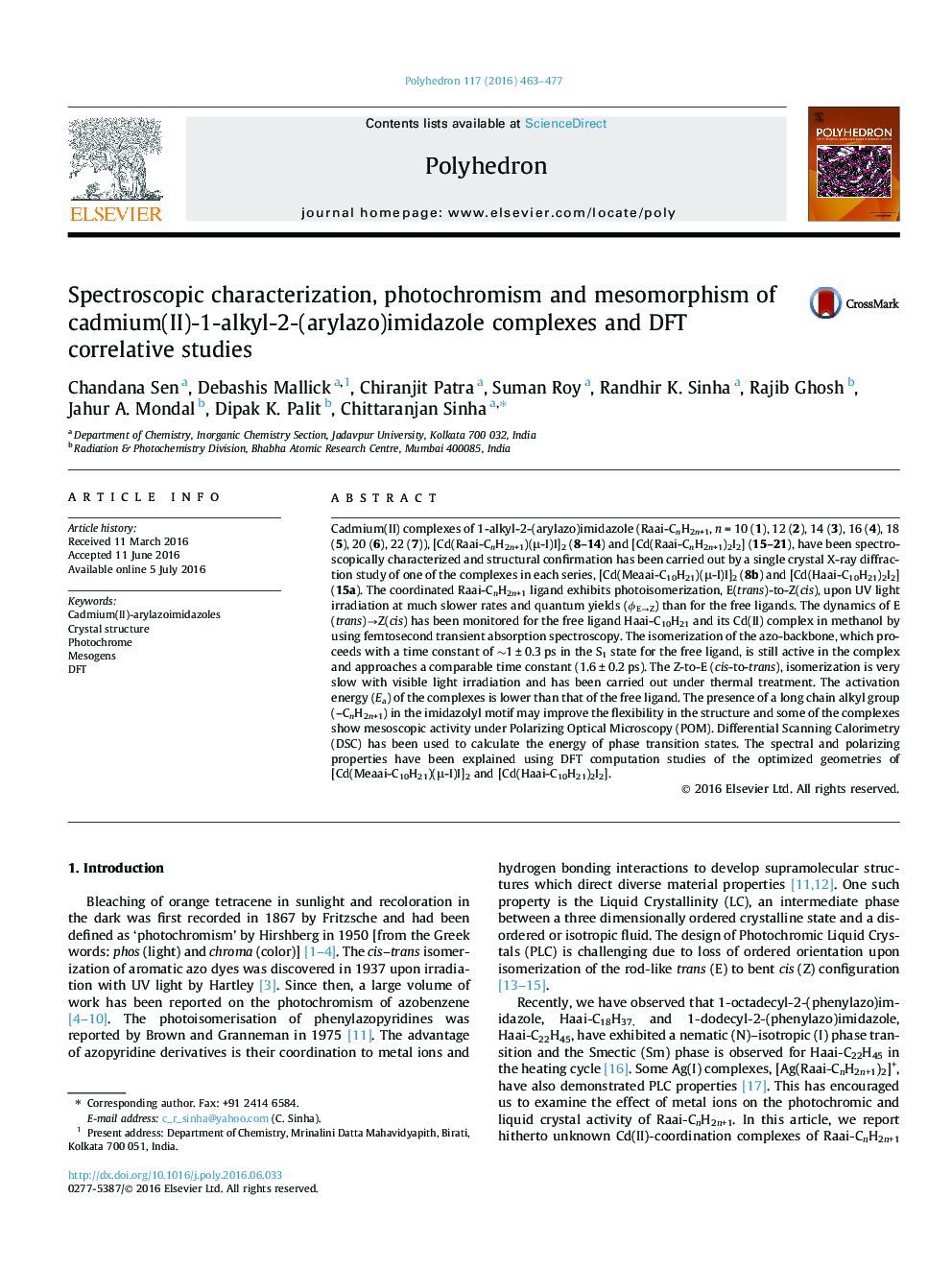| کد مقاله | کد نشریه | سال انتشار | مقاله انگلیسی | نسخه تمام متن |
|---|---|---|---|---|
| 1336229 | 1500223 | 2016 | 15 صفحه PDF | دانلود رایگان |

Cadmium(II) complexes of 1-alkyl-2-(arylazo)imidazole (Raai-CnH2n+1, n = 10 (1), 12 (2), 14 (3), 16 (4), 18 (5), 20 (6), 22 (7)), [Cd(Raai-CnH2n+1)(μ-I)I]2 (8–14) and [Cd(Raai-CnH2n+1)2I2] (15–21), have been spectroscopically characterized and structural confirmation has been carried out by a single crystal X-ray diffraction study of one of the complexes in each series, [Cd(Meaai-C10H21)(μ-I)I]2 (8b) and [Cd(Haai-C10H21)2I2] (15a). The coordinated Raai-CnH2n+1 ligand exhibits photoisomerization, E(trans)-to-Z(cis), upon UV light irradiation at much slower rates and quantum yields (ϕE→Z) than for the free ligands. The dynamics of E(trans)→Z(cis) has been monitored for the free ligand Haai-C10H21 and its Cd(II) complex in methanol by using femtosecond transient absorption spectroscopy. The isomerization of the azo-backbone, which proceeds with a time constant of ∼1 ± 0.3 ps in the S1 state for the free ligand, is still active in the complex and approaches a comparable time constant (1.6 ± 0.2 ps). The Z-to-E (cis-to-trans), isomerization is very slow with visible light irradiation and has been carried out under thermal treatment. The activation energy (Ea) of the complexes is lower than that of the free ligand. The presence of a long chain alkyl group (–CnH2n+1) in the imidazolyl motif may improve the flexibility in the structure and some of the complexes show mesoscopic activity under Polarizing Optical Microscopy (POM). Differential Scanning Calorimetry (DSC) has been used to calculate the energy of phase transition states. The spectral and polarizing properties have been explained using DFT computation studies of the optimized geometries of [Cd(Meaai-C10H21)(μ-I)I]2 and [Cd(Haai-C10H21)2I2].
[Cd(Raai-CnH2n+1)(μ-I)I]2 and [Cd(Raai-CnH2n+1)2I2] (Raai-CnH2n+1 = 1-alkyl-2-(arylazo)imidazole; n = 10, 12, 14, 16, 18, 20, 22) were structurally characterized. UV light irradiation to a solution of the complexes exhibits E(trans)-to-Z(cis) isomerisation of the coordinated Raai-CnH2n+1 ligand. The activation energy (Ea) was determined for the Z-to-E thermal isomerization, and this is lower for the complexes than the free ligand. Some of the complexes show ring-like nematic and cone-like hexatic phases under Polarizing Optical Microscopy. The spectral and polarizing properties have been explained using DFT computation studies on the optimized geometries of [Cd(Meaai-C10H21)(μ-I)I]2 and [Cd(Haai-C10H21)2I2].Figure optionsDownload as PowerPoint slide
Journal: Polyhedron - Volume 117, 15 October 2016, Pages 463–477